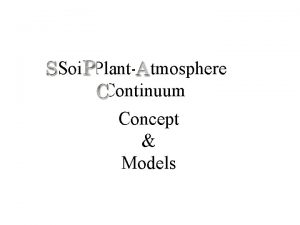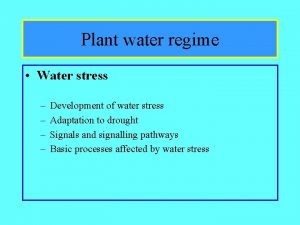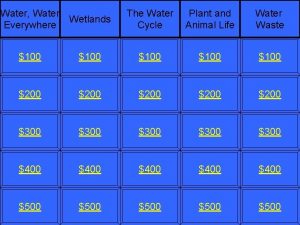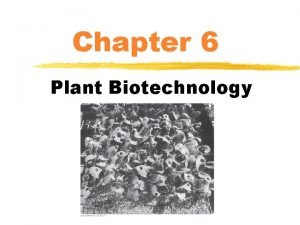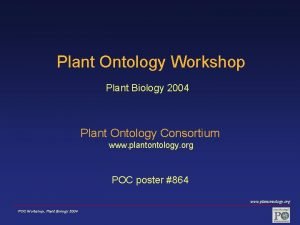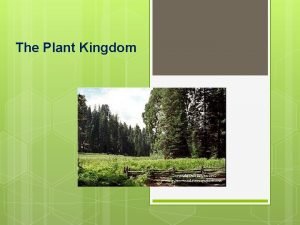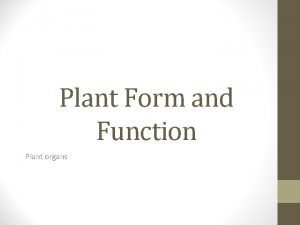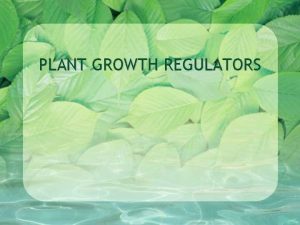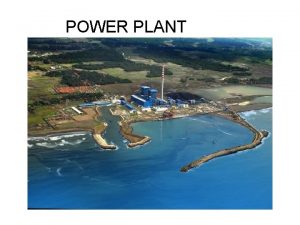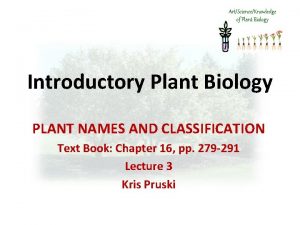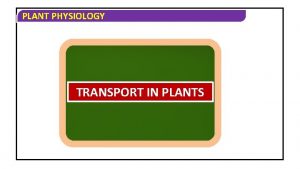Plant Water Continuum Soilplantatmosphere continuum SPAC The soilplantatmosphere





































- Slides: 37

Plant Water Continuum

Soil-plant-atmosphere continuum (SPAC) § The soil-plant-atmosphere continuum (SPAC) is the pathway for water moving from soil through plants to the atmosphere. § Continuum in the description highlights the continuous nature of water connection through the pathway. § The low water potential of the atmosphere, and relatively higher (i. e. less negative) water potential inside leaves, leads to a diffusion gradient across the stomatal pores of leaves, drawing water out of the leaves as vapour.

As water vapour transpires out of the leaf, further water molecules evaporate off the surface of mesophyll cells to replace the lost molecules since water in the air inside leaves is maintained at saturation vapour pressure. Water lost at the surface of cells is replaced by water from the xylem, which due to the cohesion-tension properties of water in the xylem of plants pulls additional water molecules through the xylem from the roots toward the leaf.

Fundamental Principles • Two general principles are indispensable for studying the SPAC: (1) the conservation principles that take the form of mass and energy ‘budgets, ’ and (2) the transport principles that relate the flow of some quantity to the difference or gradient of other quantities that influence or ‘force’ the flow and describe the ‘state’ of the exchange process. • The principles of conservation of mass and energy are the backbone of integrative studies of the SPAC. Because mass and energy can take many forms as they move throughout the SPAC, and even interact with each other, budgets are constructed to quantify the important stores and flows of important life-enabling constituents such as water, carbon, or energy. • A budget is simply the application of the conservation principles (mass or energy) to a specific system that must be carefully defined.

Role of Soil in Continuum Plant growth depends on the use of two important natural resources, soil and water. Soil provides the mechanical and nutrient support necessary for plant growth and Water is the major input for the growth and development of all types of plants. Soil provides food and fertilizers to the crops where as water mobilize the organism of plant growth and helps in introducing food and fertilizers to crops. Soil provides the room for water to be used by plants through the roots present in the same medium.

Water is the Link for Soil, Plant, and Atmosphere Continuum Water and plants Water availability limits the productivity in many ecosystems Functions within a plant § Most of plant fresh weight comes from water (up to 90%) § Provide structure and support § Source of oxygen release form photosynthesis § Medium for transporting nutrients, metabolites, and plant hormones § Lost by transpiration through stomata § Inevitable consequence of photosynthesis

Water and plants Water availability limits the productivity in many ecosystems Functions within a plant § Most of plant fresh weight comes from water (up to 90%) § Provide structure and support § Source of oxygen release form photosynthesis Medium for transporting nutrients, metabolites, and plant hormones Lost by transpiration through stomata § Inevitable consequence of photosynthesis

Leaf gas-exchange

Stomata Opening and closing are dynamically regulated

Ascent of Sap: How does water move to the tree top? • By suction • Water in the xylem is under tension • Water evaporating from the leaves (transpiration) creates this tension (i. e. , suction) • Cohesion among water molecules provides a continuous water column • Dixon and Joly (1894) • Cohesion-Tension theory Koch et al. (2004) Nature 428: 851

Soil-Plant. Atmosphere Continuum (SPAC)

Conductive Vessel Element in Mountain Mahogany Wood (SEM x 750). This image is copyright Dennis Kunkel at www. Dennis. Kunkel. com

Water movement in the soil-plant-atmosphere continuum Water moves from higher to lower water potential, so Yatmos < Yleaf < Ystem < Yroot < Ysoil

Soil water potential

Soil water adheres to soil particles of different sizes and kinds. This adhesion represents a “tension”, or YP < 0. In most soil solutions, solutes are dilute so YS ≈ 0. Exceptions: saline soils, salt marshes. YW = YS + YP + Yg YS ≈ 0 YP < 0 Yg ≈ 0 So, for most soils YW = YP Fig. 4. 2

Soils differ in characteristic particle size.

The more contact a volume of water has with the soil surface, the greater the tension with which it is held.

Water is held more tightly in small crevices. YP = -2 T/r Where r = radius (m) of curvature of meniscus, and T = the surface tension of water, 7. 28 x 10 -8 MPa m r 1 r 2

YP = -2 T/r 1. As soils dry, water is held in small pore spaces (r decreases) so soil water potential decreases 2. Soils with smaller characteristic particle size (e. g. clay vs. sand) tend to have lower water potential. 3. More difficult for plants to extract water from clay than sand

YP = -2 T/r Example: calculate YP for r = 1 x 10 -6 m and 1 x 10 -7 m. About -0. 15 MPa for 1µm, and -1. 5 MPa for 0. 1 µm.

Getting water from the soil into plant Yroot < Ysoil

How water reaches from roots to leaves? Pathway for water movement from roots to leaves. § Water can travel from the soil to the root xylem by two distinct pathways o symplastic pathways o apoplastic pathways Fig. 4. 3

§ The less-suberized growing tips of roots have higher water uptake rates than older portions of the root.

§ § Water flows from roots to leaves via the xylem Xylem is a network of specialized cells called tracheary elements. Gymnosperms have tracheids. Angiosperms have vessel elements & sometimes tracheids.


Xylem cavitation Embolisms that stop water transport can form in tracheary elements when xylem pressure is sufficiently negative to pull in air through a pit.

May 17, 2003 North of San Francisco Peaks

September 20, 2003 North of San Francisco Peaks PJ Woodland Juniper Woodland

The xylem network is extremely intricate in leaves. Fig. 4. 8

OK, we’ve got water from the soil, into the roots, and up to to the leaves.

Where does water evaporate inside leaves? The wet walls of leaf cells are the sites of evaporation.

YP = -2 T/r As for soils, a more negative YP develops as leaf cell walls dehydrate and water is held in smaller pore spaces.

The most widely accepted model of water transport through the xylem is the “cohesion-tension model”. 1. A negative pressure or tension is generated in leaf cell walls by evaporation (transpiration). 2. The cohesive property of water means this tension is transmitted to water in adjacent xylem and throughout the plant to the roots and soil.

Water potential and water flow in plants in a nutshell Water moves from one part of the plant to another down a water potential gradient. Different components of ψ are important at different stages. Soil to roots: matric potential. Roots to stems: pressure potential. Stems to cells: osmotic potential. Cells to stomata: vapor potential.

Precipitation (Yg) Overland flow (erosion, nutrients) Throughfall) Infiltration Percolation

Evapotranspiration Transpirational water loss to the atmosphere Evaporation from leaf surfaces Evaporation from soil Water transport through the plant Water uptake by plant roots

Water in the soil-plant-atmosphere continuum J = L (Dyt/l) Atmosphere Yt = - 30 MPa Water moves along a gradient of decreasing water potential Leaves Yt = - 1. 5 MPa Surface roots Yt = - 1. 1 MPa Surface soil water Yt = - 0. 8 MPa What happens at night? Stomata close – which term does this affect? How would water potential gradient respond?
 Water and water and water water
Water and water and water water Spac v uvalu
Spac v uvalu Student learning space
Student learning space Scope of plant breeding
Scope of plant breeding Plant introduction in plant breeding
Plant introduction in plant breeding Plant introduction in plant breeding
Plant introduction in plant breeding Tronsmo plant pathology and plant diseases download
Tronsmo plant pathology and plant diseases download Tronsmo plant pathology and plant diseases download
Tronsmo plant pathology and plant diseases download Tronsmo plant pathology and plant diseases download
Tronsmo plant pathology and plant diseases download Hình ảnh bộ gõ cơ thể búng tay
Hình ảnh bộ gõ cơ thể búng tay Lp html
Lp html Bổ thể
Bổ thể Tỉ lệ cơ thể trẻ em
Tỉ lệ cơ thể trẻ em Gấu đi như thế nào
Gấu đi như thế nào Tư thế worms-breton
Tư thế worms-breton Chúa yêu trần thế
Chúa yêu trần thế Các môn thể thao bắt đầu bằng tiếng bóng
Các môn thể thao bắt đầu bằng tiếng bóng Thế nào là hệ số cao nhất
Thế nào là hệ số cao nhất Các châu lục và đại dương trên thế giới
Các châu lục và đại dương trên thế giới Công thức tính thế năng
Công thức tính thế năng Trời xanh đây là của chúng ta thể thơ
Trời xanh đây là của chúng ta thể thơ Mật thư tọa độ 5x5
Mật thư tọa độ 5x5 Làm thế nào để 102-1=99
Làm thế nào để 102-1=99 độ dài liên kết
độ dài liên kết Các châu lục và đại dương trên thế giới
Các châu lục và đại dương trên thế giới Thể thơ truyền thống
Thể thơ truyền thống Quá trình desamine hóa có thể tạo ra
Quá trình desamine hóa có thể tạo ra Một số thể thơ truyền thống
Một số thể thơ truyền thống Cái miệng nó xinh thế chỉ nói điều hay thôi
Cái miệng nó xinh thế chỉ nói điều hay thôi Vẽ hình chiếu vuông góc của vật thể sau
Vẽ hình chiếu vuông góc của vật thể sau Biện pháp chống mỏi cơ
Biện pháp chống mỏi cơ đặc điểm cơ thể của người tối cổ
đặc điểm cơ thể của người tối cổ Ví dụ giọng cùng tên
Ví dụ giọng cùng tên Vẽ hình chiếu đứng bằng cạnh của vật thể
Vẽ hình chiếu đứng bằng cạnh của vật thể Fecboak
Fecboak Thẻ vin
Thẻ vin đại từ thay thế
đại từ thay thế điện thế nghỉ
điện thế nghỉ








































